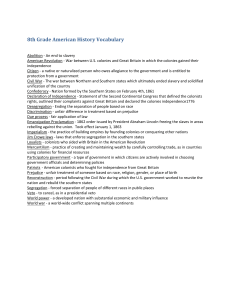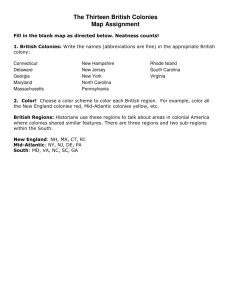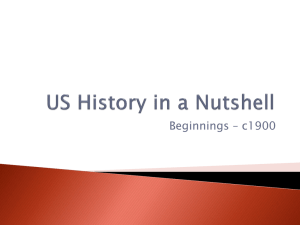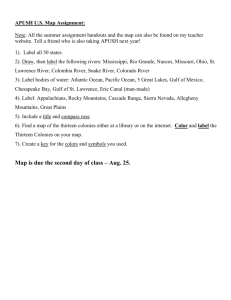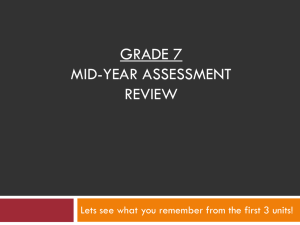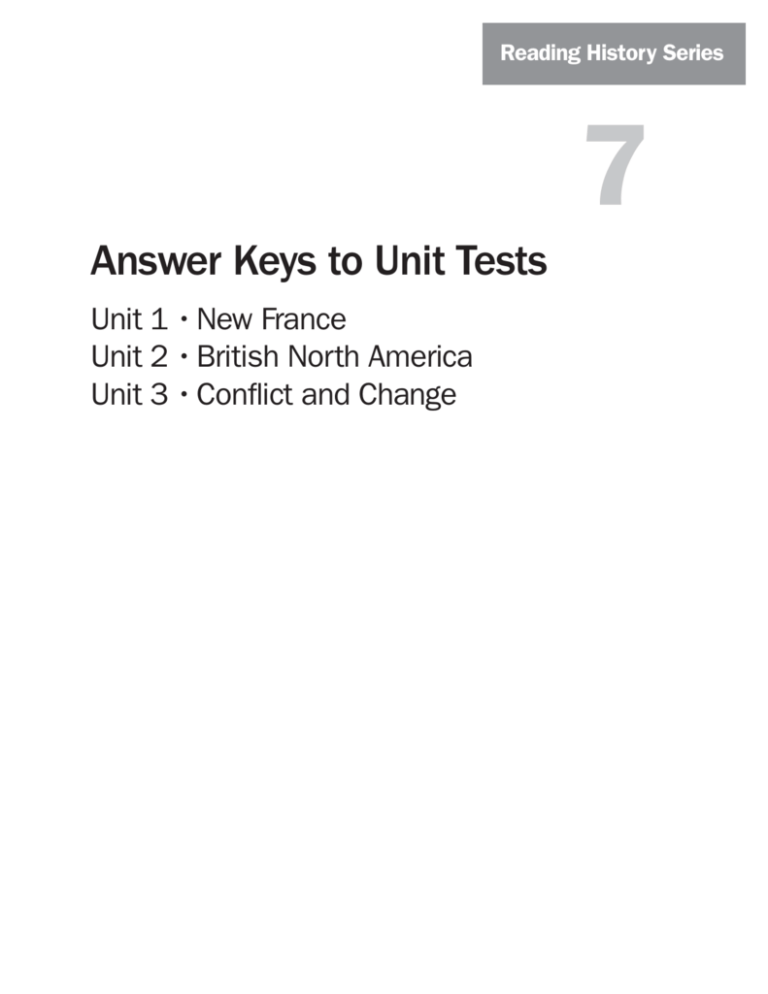
Reading History Series
7
Answer Keys to Unit Tests
Unit 1 • New France
Unit 2 • British North America
Unit 3 • Conflict and Change
Unit Test for New France
A. Understanding Key Vocabulary
Match each word on the left with its definition on the right. Place the alphabet letter
of the correct definition in the space next to the vocabulary word.
1. habitant
b
___________
a. having been removed by force
2. colony
d
___________
b. a farmer in New France
3. seigneury
e
___________
4. Quebec Act
c
___________
5. expulsion
a
___________
c. the British policy that allowed the
French to keep their language, religion,
and way of life after New France
became a British colony
d. a group of people who leave their
own country to form a settlement in
a new land
Unit Test for New France
Portage & Main Press 2007. May be reproduced for classroom use.
Reading History
©
e. land in New France that was divided
into lots for farming and granted to
a seigneur
Page 1
B. Short Answer Questions
Write a short response to each of the following questions. Include only the important
points in your answers.
1. Why did European countries, such as France and Britain, want to have colonies in
North America?
European countries such as France and Britain wanted to have colonies in
North America to increase their empires and to get access to raw materials
and riches such as animal furs.
2. Why was the fur trade such an important part of the economy of European countries?
The fur trade was a very important part of the economy of European countries
because the furs were in high demand in European countries, especially for the
making of fur hats.
3. How did First Nations peoples help the fur traders and settlers in New France?
First Nations people helped the fur traders and settlers in New France by
teaching them where and how to trap as well as trading furs to them. First
Nations people taught the settlers how to survive on the land by snowshoeing
and building shelters.
Students should identify any three of the following:
a. People came to purchase their own land.
b. Many young women (King’s Daughters) came to marry and start a new life.
c. Many men came to take part in the fur trade or fish off the coasts of
Newfoundland.
d. Soldiers came to protect the colony.
e. Missionaries came to Canada to set up mission churches, work with the
First Nations peoples, and to run schools and hospitals.
©
Portage & Main Press 2007. May be reproduced for classroom use.
4. List three reasons why people came to live in New France.
Reading History
Unit Test for New France
Page 2
5. Why did the King of France want New France to grow in population and to be less
dependent on the fur trade?
The King of France wanted New France to grow in population and be less
dependent on the fur trade because the colony was difficult to defend. If there
were more permanent settlements, it would be easier for the people to defend
the colony and fur trading would be easier.
6. What concerns did the people of New France have after they were defeated by
the British and became a British colony?
After the people of New France were defeated by the British they were
concerned that they would lose their land, their culture, and control over fur
trading forts around Hudson Bay.
C. Completing a Diagram
In the space below, make a diagram that shows what the seigneurial system looks like.
Be sure to include labels to identify each part of your diagram.
See page 14 of Unit 1 for a diagram that shows the seigneury. The diagram should be
labelled and include the seigneur’s manor house, the flour mill, the parish church, the
habitants’ long narrow tracts of lands and their houses along the river.
©
Portage & Main Press 2007. May be reproduced for classroom use.
Reading History
Unit Test for New France
Page 3
D. Labelling a Chart
The following chart
shows how New France
was governed. Fill
in the blank parts on
the chart.
King
In France
Advisors
In New
France
Sovereign Council
Governor General
Intendant
Bishop
Think about what you learned about New France in this unit. What connection can you
make between the Quebec Act passed in 1774 and what is currently happening in
Canada? Explain your thinking.
Students should be able to see that Canada’s origins begin with the First Nations people,
the French and the British. The Quebec Act of 1774 recognizes the French people and their
culture and religion but does not give them much political power. Students may connect the
ongoing importance of partnerships between Quebec and the other provinces and also see
that the French culture and religions are important to protect and maintain.
©
Portage & Main Press 2007. May be reproduced for classroom use.
E. Reflect on Your Learning
Reading History
Unit Test for New France
Page 4
Unit Test for British North America
A. Understanding Key Vocabulary
Match each word on the left with its definition on the right. Place the alphabet letter
of the correct definition in the space next to the vocabulary word.
e
1. independence ___________
2. American
Revolution
d
___________
3. migration
c
___________
4. Loyalists
a
___________
5. Patriots
b
___________
a. people who were loyal to Britain during
the American Revolution
b. people living in the Thirteen Colonies
who wanted to be independent from
Britain
c. movement of a large number of people
from one place to another
d. war between the Thirteen Colonies
and Britain
e. freedom from the control of others
©
B. Short Answer Questions
1. The British gained control of New France in 1763. Why did the British allow the
French settlers in Lower Canada to keep their civil laws, language, and religion?
The British allowed the French settlers in Lower Canada to keep their civil rights,
language, and religion to prevent them from fighting or leaving. The British
thought this would keep them loyal to the colony.
Reading History
Unit Test for British North America
Page 1
Portage & Main Press 2007. May be reproduced for classroom use.
Write a short response to each of the following questions. Include only the important
points in your answers.
2. How were the Thirteen Colonies different from other British colonies in North America?
The people of the Thirteen Colonies were from many different European
countries. The people in the other British colonies were mainly from England
and France. The Thirteen Colonies grew quickly and prospered. The people in
the Thirteen Colonies were loyal to Britain in the beginning but wanted more
independence as they grew.
3. Why did many of the settlers in the Thirteen Colonies want independence
from Britain?
Many of the settlers from the Thirteen Colonies wanted independence from
Britain because they wanted to govern themselves. They believed the British
were taxing them unfairly, stopping their expansion to the west, and limiting
their trading opportunities.
4. What happened to those people living in the Thirteen Colonies who chose to be
loyal to Britain?
The Loyalists wanted to keep British rule in the Thirteen Colonies. They were
seen as traitors and were treated badly by the Americans. The Loyalists had to
leave the United States so many moved north to the British colonies of Quebec
and Nova Scotia.
5. List three ways in which life in British North America changed after the
American Revolution. Students should identify any three of the following:
(a) New industries, such as shipbuilding, timber and manufacturing, developed
to meet the needs of the growing populations and to increase trade.
(b) New towns were founded.
(c) Transportation routes, both by land and water, were improved so that
colonists could travel easier.
(d) Governor Simcoe built schools because he believed that education was
important for the development of Upper Canada. The first schools were
mainly for the rich but eventually township schools were open so that all
children could go to school.
©
Portage & Main Press 2007. May be reproduced for classroom use.
Reading History
Unit Test for British North America
Page 2
6. Identify two positive things that happened for the people living in the British
colonies as a result of the War of 1812. Students should identify any two of
the following:
• It brought the French and British colonists together to fight the Americans.
This helped them to feel united as a nation.
• The Rideau Canal was built to ensure that shipping could continue even if the
Americans blocked the St. Lawrence River.
• More roads were built to improve transportation.
• The Maritime provinces prospered from increased trade with Britain.
7. What role did First Nations people play in the War of 1812?
The First Nations people living in the Ohio Valley fought the Americans and raided
settlements to keep the Americans off their land. Some of the Americans thought
the British were helping the Iroquois in the Ohio Valley by giving them guns. This is
one of the reasons why the Americans wanted to invade British North America in
the War of 1812.
C. True or False
Read each statement carefully. Decide if the statement is true or false. Circle the
correct answer.
1. First Nations peoples were happy that more settlers from the Thirteen Colonies
were moving farther west into the Ohio Valley.
True
False
2. The settlers in the Thirteen Colonies were unhappy with the British government.
They were not allowed to expand into the Ohio Valley, and they had to pay Britain
for the cost of military defence.
True
False
False
4. Many colonists who remained loyal to Britain during the American Revolution
fled to Canada. They were given land grants, and most settled in what are now
Nova Scotia, New Brunswick, Quebec, and Ontario.
True
False
5. The Constitutional Act of 1791 made two distinct colonies – Lower Canada and
Upper Canada. Lower Canada consisted of mainly French settlers, and Upper
Canada had mainly British Loyalists.
True
False
Reading History
Unit Test for British North America
Page 3
Portage & Main Press 2007. May be reproduced for classroom use.
True
©
3. British settlers in Quebec and Nova Scotia joined the Patriots in the Thirteen
Colonies to help defeat Britain.
D. Reflect on Your Learning
1. Think about what you learned about British North America in this unit. Below, name
the five most important things you learned. Write one thing on each post-it note.
Use the Study Notes on pages 9, 21, and 29 and Study Grade on page 30 to check
student responses for the five most important things learned.
1.
2.
3.
4.
2. Take one item from your post-it notes and write it below. Then tell how you can make
a connection between this item and something that is happening in the world today.
One important item that I learned____________________________________________
The connection to what is happening in the world today should reflect the students’
own thinking about culture, politics, war, etc.
©
Portage & Main Press 2007. May be reproduced for classroom use.
5.
Reading History
Unit Test for British North America
Page 4
Unit Test for Conflict and Change
A. Understanding Key Vocabulary
Match each word on the left with its definition on the right. Place the alphabet letter
of the correct definition in the space next to the vocabulary word.
1. culture
b
___________
a
2. Family Compact___________
3. rebellion
c
___________
4. responsible
government
e
___________
d
5. Château Clique ___________
a. a small group of people who supported
the British government and ruled the
colony of Upper Canada
b. the customs, traditions, beliefs, and way
of life of a particular group of people
c. an attempt to overthrow the government
d. a small group of people who ruled the
colony of Lower Canada
e. representatives elected by the people
to make the laws
©
Portage & Main Press 2007. May be reproduced for classroom use.
Reading History
Unit Test for Conflict and Change
Page 1
B. Short Answer Questions
Write a short response to each of the following questions. Include only the important
points in your answers.
1. Why did Britain encourage English settlers to come to Lower Canada?
Britain encouraged English settlers to come to Lower Canada to increase
the number of English people in the mainly French populated colony of Lower
Canada. The British feared there would be a rebellion unless people felt a strong
loyalty to Britain.
2. Why did some colonists in Upper Canada and Lower Canada want to rebel against
the government?
Some colonists wanted to rebel against the government because they wanted
more control in the government.
3. Lord Durham was sent from Britain to the colonies to figure out why the rebellions
had occurred. Name two recommendations he made to the British government.
• Upper and Lower Canada should join together and form a union
• Responsible Government – the leader of the largest group elected in the
Legislative Assembly would choose the members of the Executive Council
• Upper and Lower Canada were joined under one government known as the
United Province of Canada
• There was equal number of representatives in the government from Canada
West and Canada East (formerly Upper and Lower Canada)
©
Portage & Main Press 2007. May be reproduced for classroom use.
4. List two things that the Act of Union changed about Upper Canada and
Lower Canada.
Reading History
Unit Test for Conflict and Change
Page 2
C. Completing the Diagram
1. The diagram below shows how Upper Canada and Lower Canada were governed
before the rebellions took place. Fill in the blanks on the chart to complete
the diagram.
See also page 6 of Unit 3.
The Ruler of Britain
The British Parliament
Governor/
Lieutenant-Governor
Executive Council
(appointed)
Legislative Council
(appointed)
Legislative Assembly (elected)
©
After the Act of Union, Upper and Lower Canada became the United Province of
Canada. Canada West and Canada East had the same number of seats in the
Legislative Assembly. The Governor General appointed the Executive Council but
now the members had to come from the party with the most elected seats in
the Assembly. The Executive Council was ‘responsible’ to the Assembly. This was
known as Responsible Government.
Reading History
Unit Test for Conflict and Change
Page 3
Portage & Main Press 2007. May be reproduced for classroom use.
2. How did the governments in Upper Canada and Lower Canada change after the Act
of Union?
D. Reflect on Your Learning
Think about what you learned in this unit on Conflict and Change. What was one thing
you learned that helped you make a connection to something that is happening in
Canada today? Explain your thinking.
©
Portage & Main Press 2007. May be reproduced for classroom use.
Students may highlight one important event or concept (change, conflict, rebellion, cultural
differences, government, etc.) and make a reasonable connection to something similar that
is happening in Canada today. Use the study notes on page 27 and Sticky Guide on page 29
to check student responses
Reading History
Unit Test for Conflict and Change
Page 4
© 2007 Jennette MacKenzie and Susan Green
Contributors: Margaret MacKenzie, Carolyn March
All rights reserved. No part of this publication, may be reproduced or transmitted in any form
or by any means—graphic, electronic, or mechanical—without the prior written permission
of the publisher.
Printed and bound in Canada by Friesens.
Titles in the Reading History series
Unit 1: New France
ISBN: 978-1-55379-117-1
Unit 2: British North America
ISBN: 978-1-55379-116-4
Unit 3: Conflict and Change
ISBN: 978-1-55379-118-8
Teacher’s Guide
ISBN: 978-1-55379-119-5
Reading History Set
ISBN: 978-1-55379-120-1
100-318 McDermot Avenue
Winnipeg, Manitoba, Canada R3A 0A2
Email: books@portageandmainpress.com
Toll Free: 1-800-667-9673
Fax: 1-866-734-8477

